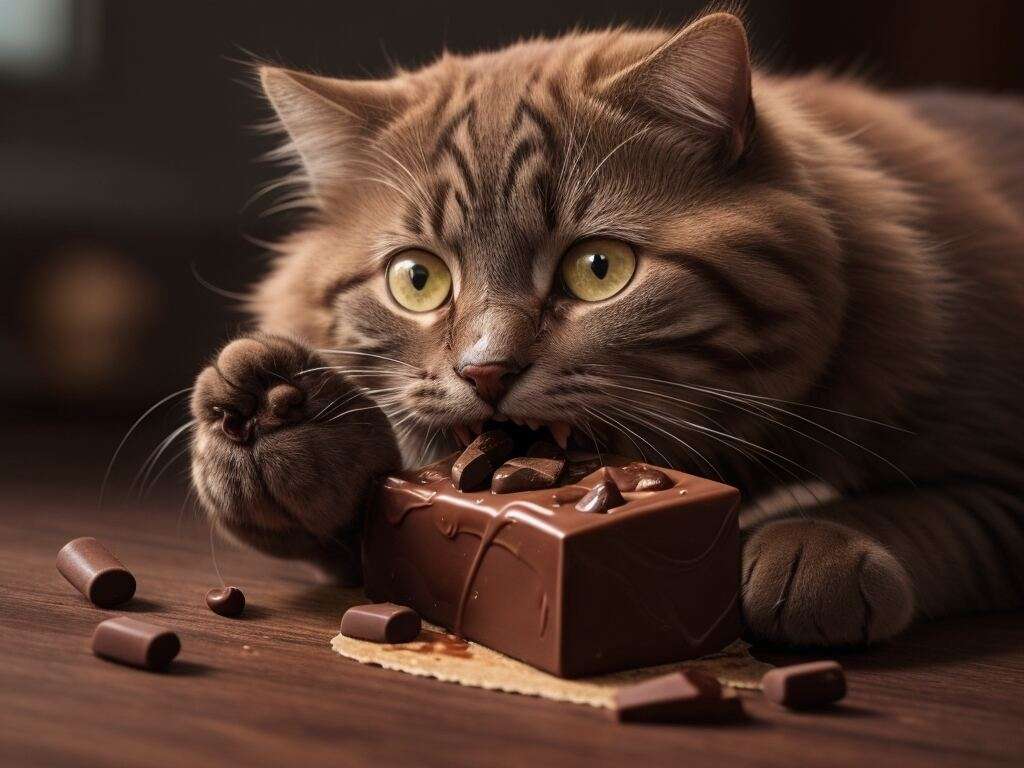Chocolate may be a beloved treat for humans, but it poses a serious threat to our feline companions. While dogs are known for sneaking a bite of anything edible, cats tend to be more selective, yet that does not make them immune to chocolate poisoning. Chocolate is just as toxic for cats as it is for dogs, possibly even more dangerous due to their smaller body size.
Learn more about: Can Cats Eat Strawberries
If you are a cat owner wondering whether a small piece of chocolate or a lick of chocolate milk could harm your pet, this guide is for you. Understanding why chocolate is toxic, how to identify the symptoms of poisoning, and what to do in an emergency could save your cat’s life.

Is Chocolate Toxic to Cats?
Yes, chocolate is highly toxic to cats. The main danger comes from two chemical substances in chocolate: theobromine and caffeine. Both belong to a class of chemicals known as methylxanthines, which are safe for humans in small quantities but dangerous to cats and dogs.
Cats do not have the necessary liver enzymes to properly process theobromine, making it build up in their system. As a result, the compound builds up in their system, leading to toxic effects that can range from mild discomfort to life-threatening complications. Because of their small size and sensitive metabolism, even tiny amounts of chocolate can pose serious health risks to cats.
Why Can’t Cats Eat Chocolate?
Unlike humans, cats can not taste sweetness. However, that doesn’t mean they are safe from chocolate-related risks. Many cats may come into contact with chocolate indirectly, by licking chocolate off a spoon, eating a piece of cake, or consuming other treats shared by their owners.
Several factors explain why chocolate poses such a high risk to cats:
- Theobromine: This compound stimulates the brain and heart, leading to potentially dangerous effects. It stays in a cat’s body for a long time, increasing the risk.
- Caffeine: As another stimulant, it may trigger symptoms like agitation, muscle tremors, and an accelerated heart rate.
- High fat and sugar: Even aside from toxicity, chocolate can contribute to digestive upset, obesity, and long-term health issues.
In many cases, chocolate exposure is accidental, but unfortunately, even a curious lick or nibble can be harmful.
Symptoms of Chocolate Poisoning in Cats
Identifying the symptoms of chocolate toxicity at an early stage is crucial. Symptoms usually begin within 6 to 12 hours after ingestion, but can appear sooner depending on the quantity consumed and the type of chocolate.
Common symptoms include:
- Vomiting
- Diarrhea
- Hyperactivity or restlessness
- Rapid breathing or panting
- Increased heart rate (tachycardia)
- Muscle tremors or twitching
- Seizures
- Elevated body temperature
- Excessive thirst or urination
- Weakness or collapse in severe cases
If your cat is showing any of these symptoms and you suspect chocolate ingestion, seek veterinary care immediately. Waiting for symptoms to worsen can reduce the chances of successful treatment.
Types of Chocolate and Their Toxicity Levels
Chocolate varies in its level of danger; certain types contain much higher amounts of toxic substances. The risk largely depends on how much theobromine and caffeine are present.
Here’s a breakdown from most to least toxic:
- Cocoa powder (the most hazardous due to its high concentration of theobromine)
- Unsweetened baking chocolate
- Dark chocolate
- Milk chocolate
- White chocolate (contains minimal theobromine but still not recommended)
Even a few grams of baking or dark chocolate can be lethal to a small cat. Never assume that a small piece is safe just because your cat “seems fine” afterward.
What You Should Do If Your Cat Consumes Chocolate
Time is critical when dealing with potential chocolate poisoning. If your cat eats chocolate, follow these steps immediately:
Call Your Veterinarian or an Emergency Pet Hotline
Don’t wait for symptoms to appear. Call your vet, the ASPCA Animal Poison Control Center (1-888-426-4435), or another trusted emergency service. Quick response can make the difference between recovery and serious complications.
Provide Key Information
Be ready to share:
- Type of chocolate
- Estimated amount eaten
- Time of ingestion
- Your cat’s weight and age
Don’t Induce Vomiting at Home
While vets may induce vomiting, this should not be done without professional supervision; it can make things worse if done improperly.
Veterinary Treatment May Include:
- Induced vomiting (within the first hour)
- Activated charcoal to absorb toxins
- IV fluids for hydration and flushing toxins
- Heart rate monitoring and seizure control medication, if needed
The earlier treatment begins, the better the outcome. In most cases, prompt intervention leads to full recovery.
How Much Chocolate Is Dangerous to Cats?
The exact toxic dose of theobromine varies by cat, but even small amounts can be dangerous. On average:
- Mild signs: 20 mg/kg of theobromine
- Severe signs: 40–50 mg/kg
- Seizures or fatal reactions: 60+ mg/kg
Here’s a rough example:
- Just 5 grams of dark chocolate can be dangerous to a 4 kg (8.8 lbs) cat.
- Milk chocolate requires more to be toxic, but still poses risks.
The best rule: Any quantity of chocolate can be harmful to cats and should be completely avoided.
Can Cats Eat Chocolate Ice Cream, Cake, or Milk?
You might wonder: What about chocolate-flavored foods? The answer remains no. These products often contain chocolate, sugar, and sometimes lactose, all of which are harmful to cats.
Common examples and risks:
- Chocolate ice cream: Chocolate ice cream includes theobromine and dairy, both of which are difficult for cats to digest.
- Chocolate milk: Includes caffeine, sugar, and lactose—triple threat for cats.
- Brownies and cake: Often contain dark chocolate, cocoa powder, and sugar, sometimes with raisins or xylitol (also toxic).
Even if the quantity of chocolate is small, the cumulative risks make these treats unsafe for any cat.
Safe Treat Alternatives for Cats
Instead of sharing chocolate, consider offering your cat healthier, species-appropriate treats. Here are some safe alternatives:
- Commercial cat treats: Choose vet-approved options low in carbs and fillers.
- Cooked plain chicken or turkey (boneless, unseasoned)
- Freeze-dried meat treats
- Catnip or cat grass: Provides sensory enrichment without risks
Always introduce new treats gradually and in moderation. When in doubt, consult your veterinarian.
Preventing Chocolate Poisoning in Cats
Most cases of chocolate poisoning in cats happen due to unintentional ingestion. Here’s how to prevent it:
- Store chocolate in sealed containers and on high shelves.
- Never leave chocolate on countertops or tables.
- Do not let children feed snacks to pets.
- Make sure guests and household members understand that chocolate is dangerous for cats.
- Be extra careful around holidays (Halloween, Christmas, Valentine’s Day).
Prevention is far easier and cheaper than emergency vet visits.
Conclusion: Keep Chocolate Far from Curious Paws
Cats and chocolate do not mix. Even a tiny amount of theobromine or caffeine can pose serious health risks, from gastrointestinal distress to seizures, or worse. While cats are less likely than dogs to seek out sweet treats, the danger remains real.
If your cat consumes chocolate, act quickly. Contact a veterinarian immediately, and never assume a “small bite” is harmless. Responsible pet ownership means knowing which human foods are off-limits, and when it comes to chocolate, it is an absolute no.
FAQs: Quick Answers About Cats and Chocolate
Yes, chocolate ingestion can be fatal, especially in small cats or with high-theobromine chocolate like cocoa powder or baking chocolate.
It contains theobromine and caffeine, which cats can not metabolize, leading to toxic buildup in their bodies.
Just 5 grams of dark chocolate may be enough to cause toxicity in cats. There is no safe amount.
No, while it has lower theobromine levels, it can still be harmful because of its fat, sugar, and other additives.
Call your vet for guidance. Even a small taste can lead to problems, depending on the kind and quantity of chocolate consumed.


Pingback: Can Cats Eat Watermelon? A Complete Guide -